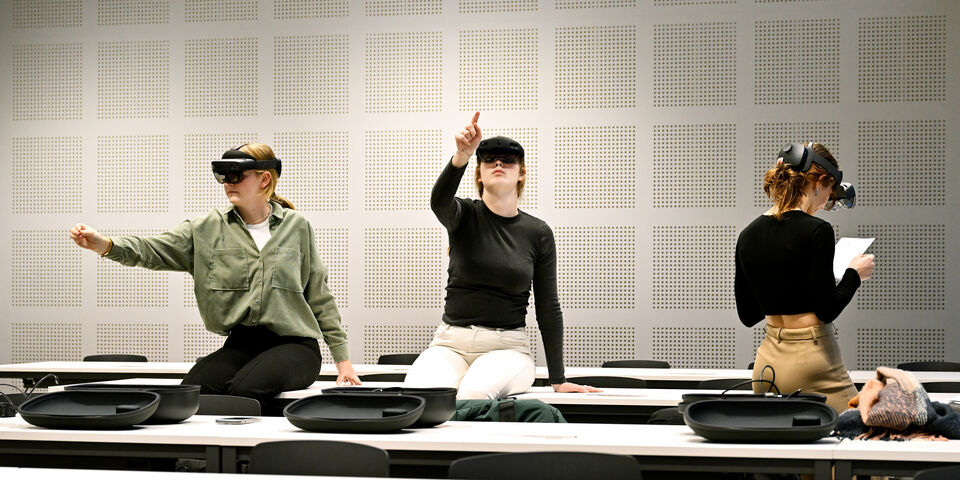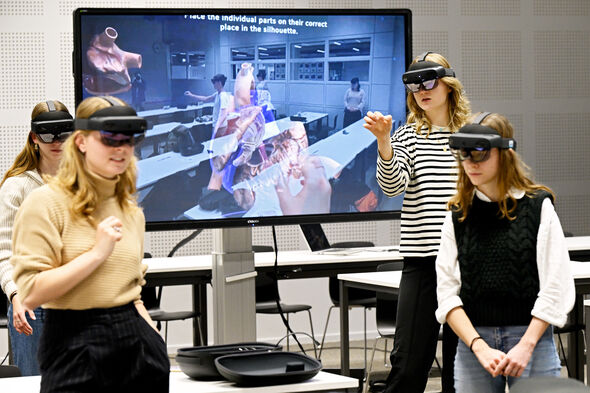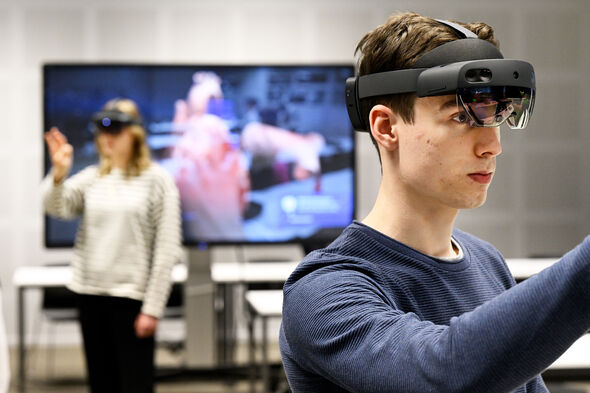The heart beats for BME students
As of this academic year, part of the subject matter of Carlijn Bouten’s course Heart & blood is discussed with the help of a 3D hologram of a heart. It’s a heart that beats, which you can view from all angles and touch if you’re wearing a HoloLens on your head. Students are very positive about this educational innovation. “Cool to see how a heart chamber contracts.”
Together with two student assistants, University Lecturer Janine Grolleman is supervising groups of students learning about the anatomy and physiology of the heart at Matrix on Tuesday afternoon. The students have donned a HoloLens 2 and are following instructions from a digital voice, with smiles on their faces. “This is so awesome,” says Mare Altorffer, second-year student of Medical Sciences and Technology (MST). “I just puzzled together the different components of the heart and when it started beating, I knew I’d done it right.” She pokes the air with her finger to activate the physiology section of the holographic menu.
XR glasses
Thanks to the use of augmented reality apps, the students can still see the surroundings and each other, as well as read the paper instruction next to the XR glasses.
Suzanne Koch, who was a postdoc at Biomedical Engineering until the end of last month, took the initiative for the use of the HoloLens at TU/e. “Beerend Hierck, educational innovator at the Veterinary Medicine faculty of Utrecht University, played a very important role in this project. His mission is to make laboratory animal education obsolete using the HoloLens,” Koch says. In February 2022 she was able to purchase the first two pairs of glasses and use them to demonstrate how education could be more active, efficient and fun.
Currently there are sixteen pairs of glasses available for the fifty students taking the Heart & blood course as an elective at Biomedical Engineering (BME) or mandatory part of the curriculum at MST. The project is funded by the BOOST! program (which aims to stimulate innovation in education at TU/e, ed.). They cost EUR 3,500 a pair, while the software being used at the moment is free.
ECG
The two existing applications cover the heart and ECGs. Until 2017, students were recording each other’s ECGs, which visualized the electrical signals sent by the heart in a graph. Koch: “Unfortunately, inaccuracies often led to deviations, while there was actually nothing wrong with the student concerned. But that did mean they’d be sent to the doctor for a check.” This practice was made impossible by the introduction of the GDPR, at which time Koch expressed her wish to start using holograms. A Swedish/Slovenian company had used EU funding to build a suitable app, which BTM gets to use for free. “"The developers there are happy that their app will continue to live on at TU/e for another two years – they’ve started making other applications in the meantime.”
New apps
While this software is good to explore the HoloLens, there’s a desire to expand the course material. “A research group at ETH Zurich is led by a passionate professor who’s involved in XR as a hobby. We’ll be working together and want our 3D models of heart valves to be viewable with a HoloLens. We also want to visualize the results of our research into, for example, the flow of liquid in the aorta,” says Koch, who has moved to UMC Utrecht for the next phase of her career.
Students who take Heart & blood visit the cutting room at UMC Utrecht, which gives them the opportunity to see the heart and other body parts in the flesh. “Although it’s an impressive visit, it concerns a heart that’s dead and therefore not beating. In this HoloLens we do see a beating heart. You can touch it and rotate it, or even enlarge it.”
Sam van Wel (BME) is the first student to leave the classroom. He has passed the concluding test consisting of ten questions. “I think it enriches the course material. I previously completed a course on cardiology, but that involved books and computer models, everything in a flat plane. I think it’s really cool to see how a heart chamber contracts. It’s definitely better than lectures.”
MST student Hadil Bellachi has a big smile on her face when she tells us how much she appreciates this way of learning. “When I’m learning from a book, I’m limited by the images it contains. If there’s something I don’t understand, I have to find other images myself. With this hologram, I can look at the heart from all sides, including the top and bottom.”
Observations
Educational researcher Suzanne Groothuijsen of the Eindhoven School of Education is there to observe, as well as speak to the students about what this teaching method means to them. She notices that students in this first session don’t really talk about the course material, but about how the software works. “It might take some getting used to. For me, the HoloLens project is a success if this new lab training makes a positive contribution to the learning experience of students and they acquire knowledge and insights they would otherwise have had to do without.”
Other users
The sixteen pairs of glasses aren’t for exclusive use by the BME department. As they also offer opportunities to other people at TU/e, a lending and borrowing system has been devised. “Gamers will be happy they can borrow our HoloLens 2. Games built in Unity can be streamed to this new model of XR glasses. Students are welcome to test any games they built themselves,” Koch says. TU/e innovation Space will have an XR wall with lockers with built-in charging systems. Students will be able to ask for the glasses at the service desk. Mark Scheffer (M.scheffer@tue.nl) is to serve as a point of contact in this regard.
Teachers can contact Janine Grolleman. “Teachers can look for apps in the Microsoft Store, try them out with the glasses and then possibly use them in a course.” She could imagine architecture teachers having students walk through buildings or chemistry teachers using the app to give students a 360-degree look at chemical structures. “There are so many possibilities. This is just the beginning.”




Discussion